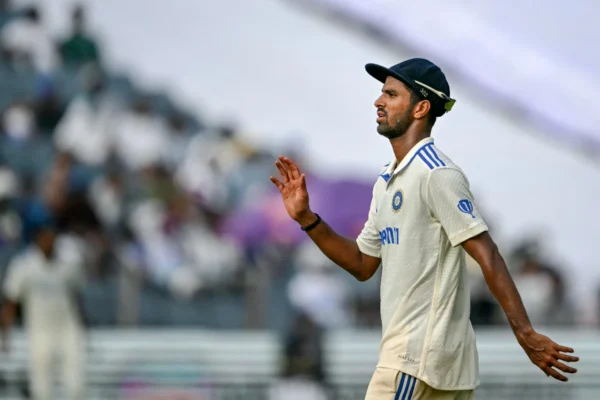
From churning out an all-round performance - 152 with the bat and 6/88 with the ball - in the Ranji Trophy in Delhi to playing a Test match after more than three years in Pune, Sundar has had a rollercoaster ride.

When Ravichandran Ashwin took the first three wickets for India in Pune, it was fitting Washington Sundar got the remaining seven wickets to end New Zealand’s innings. It was the first time two off-spinners snared all ten wickets for India in a Test innings, and the pair couldn’t have been better. Ashwin and his possible successor in the coming time.
On a day with some assistance for spinners from the first ball, Sundar didn’t really fetch instant rewards. He had to wait for his 14th over to draw the first blood. But once he got his first wicket with a ripper on the first delivery of a fresh spell, Sundar only took 61 balls to wrap the innings.
Life has been that quick and eventful for him in the last week. From churning out an all-round performance – 152 with the bat and 6/88 with the ball – in the Ranji Trophy in Delhi to playing a Test match after more than three years in Pune, Sundar has had a rollercoaster ride.
Remember his selection in the XI was out of the blue; Kuldeep had done nothing wrong to be benched, and even if the team wanted more batting depth, they had Axar Patel, a proven performer with the bat.
All this while, Washington constantly chatted with Ashwin about plans and technical aspects. He had a net session before the game, where he regularly tried taking clues from the master. Even during the match, Ashwin guided him to bowl into the body and impart more pace after the ball went soft as Sundar revealed in the post-day press conference.
Sundar used his height to good effect and imparted more over-spin, which naturally resulted in getting more bounce. Further, his high-arm release also played a role in hitting the bat higher. His control over his lengths was precise; a stat posted by a former India white-ball team analyst revealed Sundar hit the 4-6 meter mark around 75% of the time in his spell.
But this won’t be enough for him; the bar has been very high since Ashwin and Jadeja’s emergence. All spinners must also contribute with the bat and be more than handy. The chances of playing in the XI are possible only if the spinner has expertise with the willow; specialists are long gone.
There’s a reason why Kuldeep Yadav, a genuine wicket-taker, has played only 13 Test matches in a 7-year-long career. He has recently improved massively with the willow and can score vital runs in the lower order, but the bar is high again. Take Axar Patel, for instance; he is among the finest players of spin and can bat anywhere in the order while averaging 19.34 with the ball.
Remember the likes of Jayant Yadav of the past? Even he has a Test century. So, naturally, Sundar is expected to contribute with the bat, and there’s potential, as his First Class average of 33.28 depicts.
Also Read: A glimpse of vintage Virat Kohli, yet uncertainty lingers
However, Sundar’s best batting value is when he bats up in the order and sees himself as a top-order batter. But he will have to bat in the lower middle order in the Indian setup. Even if he replaces Ashwin in the longer run, his batting position might be No.7.
That can be tricky, for batters need to be as flexible as possible at that number to bat in different situations. Sundar has two centuries, converting both into 150s, but both have come while batting in the top order, once while opening and the other at No.3. So, making such a drastic change won’t be easy.
To Sundar’s credit, he has already shown flashes of brilliance during his knock against Australia at The Gabba and against England in Chennai in his young career as a batter. India were in a precarious position in both innings, and Sundar navigated threats and weaved prudent knocks while batting with other lower-order batters. But his bowling wasn’t convincing enough then.
He was still new and learning tricks to be a workhorse in the red-ball format. His bowling was mostly engineered to suit white-ball formats, where he would bowl at a certain pace, defensive lines, and mostly flatter. That also happened when one of Ashwin-Jadeja or both were absent, but this late inclusion might be when he finally finds his feat as an all-rounder.
Soon, India will look for alternatives to replace Ashwin, 38. He has shown signs of regression lately, even if in patches, and the team can’t overlook them as he won’t get young again. Maybe Sundar mirroring his career-best record wasn’t a mere coincidence.
For more updates, follow CricXtasy on Facebook, Instagram, Twitter, Telegram, and YouTube.